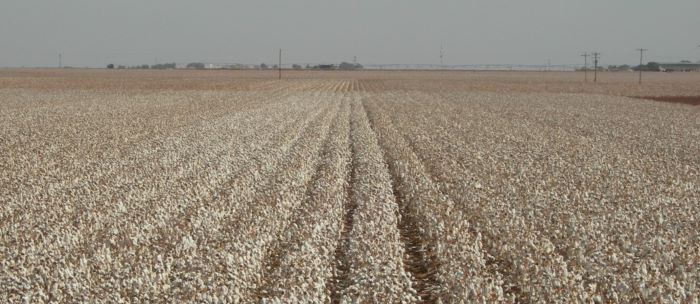Crop Scan Ag Report: Cotton Looks Good as Defoliation Begins Beltwide
Getting the 2023 cotton crop harvest-ready is the focus across the Cotton Belt, as more and more acres are being defoliated over the next few weeks. Despite some weekend rains and wind from a tropical storm in the Carolinas, our contributing consultants say the cotton crop looks good overall, with fingers are crossed for solid harvest results.
This is the final Crop Scan Ag Report for the 2023 season. Many thanks to our contributing consultants for their time and input.
Chad Harrell owns and operates Harrell Agronomic Services in Northeastern North Carolina.
We have gotten off to slow start defoliating due to a tropical storm over the weekend. Most of our cotton is 4-5 NACB and ready to be defoliated, although most growers have decided to wait until the storm passes in hopes of less exposure to wind and hard lock.
We received about 4 inches of rain from the tropical storm and some moderate wind, but I don’t think we have much loss from wind.
Hard lock is my biggest concern now as we are predicted to have cloudy days and rain chances most of this week. We will be in full swing defoliating this week as soon as we see some favorable conditions. Regrowth has been bad this year and will continue with the recent moisture. Growers should use high rates of TDZ products and harvest timely after defoliation.
Looking ahead to harvest, we won’t have yields that we have seen in the past couple years due to the drought and hard cut out in August, although we still have a solid crop in most areas.
Wes Briggs consults on cotton, corn, peanuts, soybeans, and small grains for growers in Georgia, Alabama, and Florida.
We just started defoliating a little bit of cotton this week. Cotton is maturing out and opening up pretty fast. We haven’t had a lot of rain, so we’ve been able to manage our water on the irrigated acres. We’re probably 10-12 days away from starting defoliation on those acres.
Everybody is wide open in peanuts right now.
We have a decent amount of late planted cotton in my area, so we’re still putting out plenty of Pix, taking care of stinkbugs, and watering. Probably 15-20% of those acres may go to November 1. We do have some dryland cotton picked, but no yield results back yet. It looks like could be anywhere from less than a bale up to 1,000 pounds on fields that caught an early rain.
Overall, we don’t have the cotton crop we had last year. Just too much heat during the summer. If the weather remains consistent, most of our cotton is probably going to be in the 1,100-to-1,300-pound range, based on boll size, seed count, and other factors.
The short-range weather forecast calls for more dry weather. We don’t need it to start raining now. It’s too late to help cotton or peanuts. It’s going to be what it’s going to be.
Tucker Miller is a Mississippi-based independent private consultant for cotton, soybeans, corn, peanuts, rice, and vegetables.
We have hit most all of our cotton with the first shot of defoliant. We used Dropp, Prep, and added AMS. We applied our second shot this past week using Prep and ET.
We will get a few pickers started to work out the kinks. If we miss the rain predicted over the weekend, we’ll start rolling the first of next week.
 (Tucker Miller)
(Tucker Miller)
Most of our cotton looks pretty good. Furrow irrigated looks better than pivot, which looks better than dryland. Our ThryvOn cotton looks good, and we are looking for good varieties going forward. The hot temperatures in August probably affected our top crop, along with irrigation timing and scheduling.
Looking forward, we will be evaluating new varieties and the results of cover crop acres to make plans for next year. Hope everyone has a great harvest season.
Mark Nemec is an independent agricultural consultant for cotton, wheat, grain sorghum and corn in the Blacklands and Brazos River Bottom area of Central Texas.
Things are wrapping up fast in Central Texas. Most of the dryland cotton has been harvested with disappointing yields. Irrigated cotton is being defoliated now, and some pickers are starting to roll. Of course, all the rain we prayed for finally got here last week. We received 1.5-2 inches in most areas. Maybe now defoliation will be easier without all the dust on leaves.
With the extreme daytime high temperatures along with record high nighttime temps, this crop never had a chance to catch its breath. Much of it seemed to mature faster than it could handle. We were able to set a good number of bolls, but they developed so quickly that our seed count is lower than average, especially on the upper parts of the plants.
Growers are ready to put this year to bed and get ready for next year. Just hope the next crop wakes up on the right side of the bed.
Kerry Siders is Texas A&M AgriLife Extension Agent-IPM for Hockley, Cochran, and Lamb Counties.
Cotton harvest here on the Texas South Plains is inching closer by the day. Harvest aids are just now starting to go out on some very mature cotton. The rains we received recently have caused some fields to green back up with late growth which will make setting these fields up for harvest a bit more of a challenge.
Ethephon at a quart rate is at the backbone of most all our harvest aid applications. Then it is a matter of selecting your favorite defoliant. The defoliation products all generally work well here. I remind producers to pay attention to what the manufacturers recommend as adjuvants with these products, particularly the PPO’s (Aim, ETX, Sharpen, and Reviton). To deviate can cause poor performance.
Also, some defoliants can be temperature sensitive. As it cools, some of the defoliants such as Ginstar may require a bump in rate.
That leaves us with the desiccants, which are primarily paraquat products. Again, I remind producers that paraquat is activated by sunlight. If it is applied early in the day, it will generally result in a rapid burn of the plant tissue and result in typical desiccation (sticking of leaves). Versus an application applied later in the day, the paraquat will move deeper in the plant tissue (local systemic or translaminar movement). This can result in both desiccation and additional defoliation.
Have a safe harvest.
 (Kerry Siders)
(Kerry Siders)















